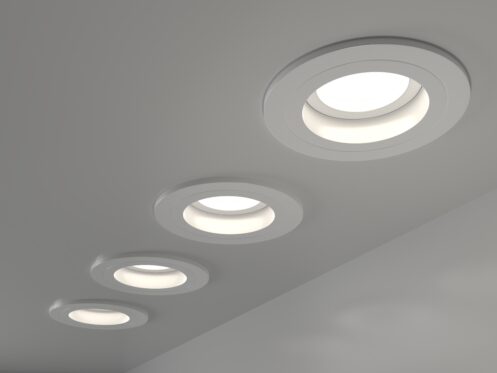There is very clear research showing the impact that indoor lighting can have on a person’s life. There’s no question that natural light from the sun can improve a person’s mood, make them more creative, and make it easier for them to perform some cognitive functions. In an indoor setting, warm lighting can make a person feel relaxed and can be a catalyst for focus and concentration. Indoor lighting can be designed to reproduce some of the positive effects obtained from natural light.
How Natural Lighting Affects a Person’s Mood
Many studies highlight how outdoor lighting affects a person’s mood, but stepping outside on a sunny day allows one to experience these effects firsthand. Specific intensities and colors of light foster positive feelings and sharpen mental clarity.
Certainly, darkness proves ideal in some situations. For instance, when it’s time to sleep, most people prefer a dark room over a bright one. However, humans generally spend the majority of their time in illuminated settings.
Natural light without glare enhances creativity and lifts a person’s mood. Adequate light positivity impacts how you feel about your life. Moreover, a positive mood enables better relationships with others and quicker problem-solving, benefiting those around you.
Filling the Gap With Artificial Light
While natural lighting is unmatched in its benefits, the truth is that the majority of people spend most of their days indoors. Some may have windows around them, but most do not. Artificially generated light can fill the gap when natural light is not sufficient.
Circadian lighting systems are designed to provide a variety of light throughout the day. It is designed to mimic natural illumination. This can help the body keep its circadian rhythms, minimize stress, and lead to overall well-being.
The Color of Artificial Light
The color of indoor light can vary drastically. Lightbulbs can either have a warm or cool temperature. When you purchase a light bulb, there is usually some indication on the package of where the light sits on the spectrum of warm to cool.
If you have a home office, you want to use whitish lightbulbs. Stay away from lightbulbs that are tinted blue, green, or red. These lights will distort the colors on the surfaces that you are working on and can have a negative impact on how you feel.
If you’re adding lighting to your living room, bedroom, or entertainment area, you may want to lean toward warmer lights. These are designed to create a relaxing, cozy atmosphere. This type of atmosphere promotes socializing and the ability to think creatively.
Cooler lights are best for when you need to be alert or active. They are great for when a person needs to concentrate. But when it comes time to hang out with friends and enjoy some casual time, a dimmer, warmer light is in order.
Some people opt to have multiple lighting sources in one room. They can change the lighting in the room from warm to cool depending on the activities they plan to engage in.
Warmer lights are most effective with tabletop and floor lamps. Cooler lights work better when they are installed overhead. For example, ceiling-mounted fixtures with cooler lights are more conducive to an effective work environment.
Warm and cool light are found in nature. Just think about the light produced by the sun at noon compared to the light you see when the sun is setting or rising. At noon, the sun is projecting its full power in cool light. In the evening and early morning, the sunlight is warmer, taking on a red, pink, and orange color.
If Your Home Does Not Get Enough Light, Do This
If your home does not get a lot of natural light, you can use artificial lighting to achieve full daytime brightness by using full-spectrum light bulbs. Full-spectrum light bulbs replace natural sunlight. When they are properly installed, you can benefit from the visible and invisible forms of light, such as infrared and ultraviolet. These full-spectrum lights have a daylight-mimicking effect that can boost alertness, lower stress, and reduce levels of hormones like cortisol in the human body.
If you have a dimmer installed, you can use it to imitate the sun setting. You can gradually turn it down as you get into the evening. This might lead to improved sleep as well. Sitting beneath bright lights at night can affect your body’s release of melatonin. This, in turn, can make it difficult to fall asleep. The same is true with exposure to blue light and white light with blue hues. These are commonly seen in LED and fluorescent bulbs. A dimmer may help counteract some of these effects.
Installing Different Lighting in Different Rooms
Using different types of lights in various rooms enhances positive mental states. For instance, installing bright lighting in your kitchen, such as undercabinet lights, increases safety, boosts productivity, and prevents eyestrain.
In the bathroom, light color significantly influences how we perceive ourselves in the mirror. You should install ample lighting for clear visibility. Ensure the lighting emits a warm tone to avoid unnatural skin coloration.
Some homeowners place nightlights in bathrooms and other areas for middle-of-the-night navigation. This lighting should emit a dim, warm glow, preferably in the amber/red range, to preserve your ability to return to sleep.
In the living room, warmer ambient lighting promotes relaxation and facilitates social interaction. Similarly, in bedrooms, ambient lighting doesn’t hinder your sleep quality.
Choose the Right Layer of Light
When installing a ceiling fan, chandelier, pendant light, track lighting, recessed lighting, or wall sconces, select the appropriate layer of light for your needs. Three layers exist: ambient, task, and accent. The room’s size and purpose dictate which layers you require. Typically, you’ll need at least two layers to light a room adequately.
Ambient Lighting
Every room requires ambient lighting, which provides a general level of comfort. Install overhead options like ceiling fans and lighting fixtures for ambient lighting. When setting up a room, most people begin by choosing ambient lighting. Consider track lighting, semi-flush mount ceiling fixtures, or recessed lighting for this purpose.
Task Lighting
Task lighting illuminates specific activities, such as cooking, reading, or applying makeup. This direct light aids in detailed tasks and is common in kitchens, bathrooms, and offices. Utilize desk lamps, track lighting, undercabinet lighting, or work lamps for effective task lighting.
Accent Lighting
Accent lighting highlights decorative elements like mantels, paintings, or art pieces. It serves as a secondary light source that complements ambient lighting. While ambient lighting comes from overhead, accent lighting targets areas not well-covered by ambient light. Opt for wall sconces, recessed lighting, or track lighting for accentuating specific parts of a room.
Trusted Plumbing, HVAC, and Electrical Experts in Chatham, New Jersey
If you’re looking for a great home service company, you have hit the jackpot with Pipe Works Services. Since 2000, we have led the fields of plumbing, HVAC, electrical, and home insulation services. We offer 24-hour day, seven days a week emergency help and a 100% customer satisfaction guarantee.
Our services include HVAC installation, repair, and maintenance. Our team also installs boilers, ductless heating, and heat pumps. We do general plumbing repair, water heater and water treatment installation, and drain cleaning. Customers trust us for complete interior and exterior electrical services and insulation, weatherization, indoor air quality, and ductwork services. Contact Pipe Works Services today and see for yourself why our services are so highly prized.




